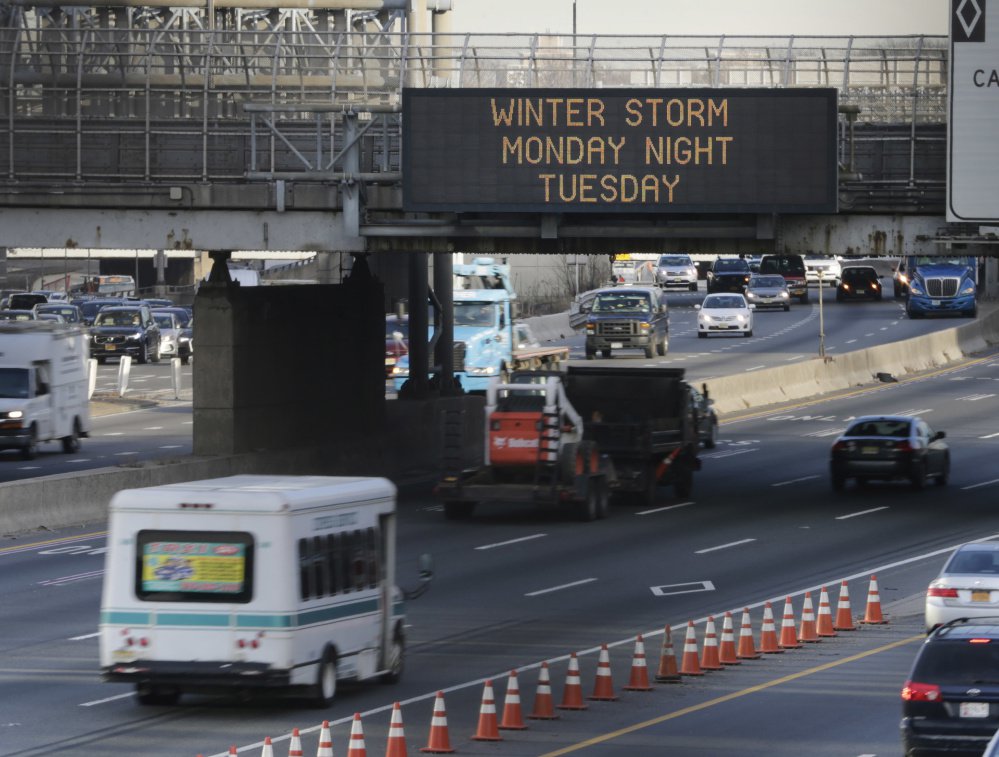BOSTON — Grounded flights and soaring power prices roiled the Northeast as a late-winter storm prepared to spin up the Atlantic Coast, threatening New York with an overnight blizzard, postponing German Chancellor Angela Merkel’s trip to Washington and promising snow by the foot in Boston.
As many as 19 inches could land in New York, the National Weather Service said, with the snow starting to fall after midnight and ramping up to rates of 2 to 4 inches per hour.
New York and Boston closed public schools Tuesday in anticipation.
“There will be pretty hefty snowfall totals across the entire Northeast,” said Marc Chenard, a forecaster with the U.S. Weather Prediction Center in College Park, Maryland.
The culprits are one low-pressure system that moved Monday across the Midwest, where it brought snow to Chicago, and another over the Atlantic Ocean off South Carolina. The energy from the first will feed the second as it grows in strength, creating a nor’easter.
A shift in the system’s track as it barrels up the coast could create a precipitation mix for some cities. It’s expected to pass over Cape Cod in Massachusetts, which might bring more rain and sleet to Boston instead of a steady snowfall.
Washington will also probably see a mix, Chenard said, but New York is likely to be buried in snow alone.
While it might seem late in the season for a big snowfall, it’s not out of the ordinary, he said. “We thought we could get out of the winter without this, but that’s not going to happen.”
New York has been hit by massive March storms many times. The Blizzard of 1888, which killed 400 across the Northeast and 200 in the city alone, ranks at the top of the historic list, according to Weather Underground in Ann Arbor, Michigan.
“This is historic in the sense that we are adding to history, but not unprecedented,” said Brian Hurley, senior branch forecaster at the Weather Prediction Center.
Blizzard warnings and watches stretched from New Jersey to Massachusetts, and winter storm warnings and weather advisories reached from Illinois to Maine. Both Philadelphia and Boston could get about a foot, and Washington might get 5 inches. Emergencies have been declared in New Jersey, Connecticut and Virginia.
But Intercontinental Exchange Inc.’s New York Stock Exchange expects to operate business as usual Tuesday, as do Nasdaq Inc.’s markets.
The cold that dropped into the region pushed April natural gas contracts up. They rose 3.5 cents to $3.043 per million British thermal units on the New York Mercantile Exchange, the highest settlement since Feb. 9.
New York Gov. Andrew Cuomo warned truckers to expect closed roads, while Amtrak suspended Acela train service between Boston and New York and cut back its schedule to Washington. More than 6,400 flights across the United States were canceled, said FlightAware, a Houston-based airline tracker.
The threat to travel caused Innophos Holdings Inc. in Cranbury, New Jersey, and EPAM Systems Inc. in Newtown, Pennsylvania, to postpone shareholders’ meetings. The House of Representatives won’t schedule any votes for Tuesday. The German chancellor’s trip to Washington for talks with President Trump was postponed until March 17, White House spokesman Sean Spicer said.
Utilities from Washington to Maine positioned crews and prepared for the worst from the storm that could bring wind gusts as strong as 60 mph along with the blizzard. “Bucket trucks can’t operate with gusts reaching 50 miles per hour,” said Karen Johnson, a spokeswoman for Newark-based Public Service Enterprise Group’s PSE&G.
Snow will probably fall most heavily in the early hours Tuesday, said Melissa Di Spigna, a weather service meteorologist in Upton, New York. “The morning commute is really going to be rough.”
Send questions/comments to the editors.



